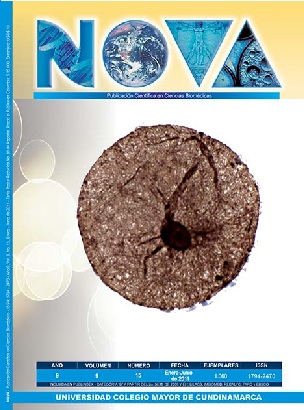Coexistencia de Pseudomonas aeruginosa y Candida albicans en infecciones nosocomiales en Cartagena de Indias (Colombia)
Coexistence of Pseudomonas Aeruginosa and Candida albicans in hospital-acquired infections in cartagena (colombia)
Las infecciones nosocomiales constituyen un importante problema de salud, cuyos factores de riesgo son hospitalizaciones prolongadas, procedimientos invasivos y tratamientos antimicrobianos de amplio espectro. Pseudomonas aeruginosa y Candida albicans son microorganismos frecuentemente aislados del tracto respiratorio de pacientes gravemente enfermos. Se ha demostrado que estos patógenos pueden tener una interacción de gran significancia en donde las características morfológicas y de virulencia de cada microorganismo se modulan mutuamente aumentando significativamente el riesgo y la severidad de las infecciones urinarias y respiratorias produciendo una alta morbimortalidad. El objetivo de este trabajo fue ilustrar las características microbiológicas y clínicas que son resultado de la presencia conjunta de P. aeruginosa y C. albicans en pacientes gravemente enfermos en hospitales de Cartagena de Indias (Colombia). En todos los casos se destaca un proceso bacteriano inicial, en este caso causado por P. aeruginosa, que fue tratado de acuerdo a la susceptibilidad antimicrobiana encontrada y al disminuir el agente bacteriano responsable se dio lugar al crecimiento de C. albicans y al desarrollo de una nueva infección que empeoró la condición clínica de estos pacientes.
Las infecciones conjuntas entre P. aeruginosa y C. albicans siempre se deben sospechar en un paciente hospitalizado, especialmente en unidades de cuidados intensivos y cuando hagan uso de sondas, catéteres y otros materiales para estudios invasivos, pues estos microorganismos son de naturaleza oportunista y claramente pueden empeorar el pronóstico y llevar a complicaciones a pacientes que han sido hospitalizado por causas diferentes o enfermedades de baja complejidad, prolongando el tiempo de hospitalización y aumentando costos.
Visitas del artículo 338 | Visitas PDF 161
Descargas
- Smith RL. Prevention of infection in the intensive care unit. Curr Opin Infect Dis 2006; 19(4):323-6.
- Fridkin SK, Welbel SF, Weinstein. Magnitude and prevention of nosocomial infections in the intensive care unit. Infect Dis Clin North Am 1997; 11(2):479-96.
- Division of Healthcare Quality Promotion, National Center for Infectious Diseases, Centers for Disease Control and Prevention, Public
- Health Service, US Department of Health and Human Services. National Nosocomial Infections Surveillance (NNIS) System Report, data summary from January 1992 through June 2004, issued October 2004. Am J Infect Control 2004; 32:470–485.
- Craven DE. Preventing ventilator-associated pneumonia in adults: Sowing seeds of change. Chest 2006; 130:251–260.
- Warren JW. Catheter-associated urinary tract infections. Int J Antimicrob Agents 2001; 17(4):299-303.
- Niederman MS. Use of broad-spectrum antimicrobials for the treatment of pneumonia in seriously ill patients: maximizing clinical outcomes and minimizing selection of resistant organisms. Clin Infect Dis 2006; 42 Suppl 2:S72-81.
- Shigemura K, Arakawa S, Sakai Y, Kinoshita S, Tanaka K, Fujisawa M. Complicated urinary tract infection caused by Pseudomonas aeruginosa in a single institution (1999-2003). Int J Urol 2006; 13(5):538-42.
- Kollef MH, Morrow LE, Niederman MS, Leeper KV, Anzueto A, Benz-Scott L, Rodino FJ. Clinical characteristics and treatment patterns among patients with ventilator-associated pneumonia. Chest 2006; 129(5):1210-8.
- Lanotte P, Watt S, Mereghetti L, Dartiguelongue N, Rastegar-Lari A, Goudeau A, Quentin R. Genetic features of Pseudomonas aeruginosa isolates from cystic fibrosis patients compared with those of isolates from other origins. J Med Microbiol 2004; 53(Pt 1):73-81.
- Horii T, Muramatsu H, Morita M, Maekawa M. Characterization of Pseudomonas aeruginosa isolates from patients with urinary tract infections during antibiotic therapy. Microb Drug Resis 2003; 9(2):223-9.
- Delisle MS, Williamson DR, Perreault MM, Albert M, Jiang X, Heyland DK. The clinical significance of Candida colonization of respiratory tract secretions in critically ill patients. J Crit Care 2008; 23(1):11-7.
- Kerr JR. Suppression of fungal growth exhibited by Pseudomonas aeruginosa. J Clin Microbiol 1994; 32(2):525-7.
- Liu Y, Kang Y, Yokoyama K, Gonoi T, Mikami Y. Molecular differentiation and antifungal susceptibility of Candida albicans isolated from patients with respiratory infections in Guiyang Medical College Hospital, China. Nippon Ishinkin Gakkai Zasshi 2009; 50(3):175-8.
- Pierce GE. Pseudomonas aeruginosa, Candida albicans, and device-related nosocomial infections: implications, trends, and potential approaches for control. J Ind Microbiol Biotechnol 2005; 32(7):309-18.
- Hogan DA, Vik A, Kolter R. A Pseudomonas aeruginosa quorum-sensing molecule influences Candida albicans morphology. Mol Microbiol 2004; 54(5):1212-23.
- Roux D, Gaudry S, Dreyfuss D, El-Benna J, de Prost N, Denamur E, Saumon G, Ricard JD. Candida albicans impairs macrophage function and facilitates Pseudomonas aeruginosa pneumonia in rat. Crit Care Med 2009; 37(3):1062-7.
- Barry AL, Brown SD. Fluconazole disk diffusion procedure for determining susceptibility of Candida species. J Clin Microbiol 1996;
- (9):2154-7.
- Brand A, Barnes JD, Mackenzie KS, Odds FC, Gow NA. Cell wall glycans and soluble factors determine the interactions between the hyphae of Candida albicans and Pseudomonas aeruginosa. FEMS Microbiol Lett 2008; 287(1):48-55.
- Nseir S, Ader F. Pseudomonas aeruginosa and Candida albicans: do they really need to stick together?. Crit Care Med 2009; 37(3):1164-6.
- Liu H. Co-regulation of pathogenesis with dimorphism and phenotypic switching in Candida albicans, a commensal and a pathogen. Int J Med Microbiol 2002; 292(5-6):299-311.
- Saville SP, Lazzell AL, Monteagudo C, Lopez-Ribot JL. Engineered control of cell morphology in vivo reveals distinct roles for yeast and
- filamentous forms of Candida albicans during infection. Eukaryot Cell 2003; 2(5):1053-60.
- Balish E, Wagner RD. Probiotic bacteria for prophylaxis and therapy of candidiasis. Rev Iberoam Micol 1998; 15(4):261-4.
- Payne S, Gibson G, Wynne A, Hudspith B, Brostoff J, Tuohy K. In vitro studies on colonization resistance of the human gut microbiota to Candida albicans and the effects of tetracycline and Lactobacillus plantarum LPK. Curr Issues Intest Microbiol 2003; 4(1):1-8.
- Hogan DA, Kolter R. Pseudomonas-Candida interactions: an ecological role for virulence factors. Science 2002; 21;296(5576):2229-32.
- Kerr J. Inhibition of fungal growth by Pseudomonas aeruginosa and Pseudomonas cepacia isolated from patients with cystic fibrosis. J Infect
- ; 28(3):305-10.
- Foweraker J. Recent advances in the microbiology of respiratory tract infection in cystic fibrosis. Br Med Bull 2009; 89:93-110.
- Tan MW, Rahme LG, Sternberg JA, Tompkins RG, Ausubel FM. Pseudomonas aeruginosa killing of Caenorhabditis elegans used to identify P. aeruginosa virulence factors. Proc Natl Acad Sci U S A 1999; 96(5):2408-13.
- Tan MW, Ausubel FM. Caenorhabditis elegans: a model genetic host to study Pseudomonas aeruginosa pathogenesis. Curr Opin Microbiol
- ; 3(1):29-34.
- Soll DR. Candida commensalism and virulence: the evolution of phenotypic plasticity. Acta Trop 2002; 81(2):101-10.
- Brown DH Jr, Giusani AD, Chen X, Kumamoto CA. Filamentous growth of Candida albicans in response to physical environmental cues and its regulation by the unique CZF1 gene. Mol Microbiol 1999; 34(4):651-62.
- Falleiros de Pádua RA, Norman Negri MF, Svidzinski AE, Nakamura CV, Svidzinski TI. Adherence of Pseudomonas aeruginosa and Candida albicans to urinary catheters. Rev Iberoam Micol 2008; 25(3):173-5.
- Perepnikhatka V, Fischer FJ, Niimi M, Baker RA, Cannon RD, Wang YK, Sherman F, Rustchenko E. Specific chromosome alterations in
- fluconazole-resistant mutants of Candida albicans. J Bacteriol 1999; 181(13):4041-9.
- Ruhnke M, Eigler A, Tennagen I, Geiseler B, Engelmann E, Trautmann M. Emergence of fluconazole-resistant strains of Candida albicans in patients with recurrent oropharyngeal candidosis and human immunodeficiency virus infection. J Clin Microbiol 1994; 32(9):2092-8.
- White TC, Marr KA, Bowden RA. Clinical, cellular, and molecular factors that contribute to antifungal drug resistance. Clin Microbiol Rev 1998; 11(2):382-402
- -------------------------------------------------------------------------------
- DOI: http://dx.doi.org/10.22490/24629448.485










